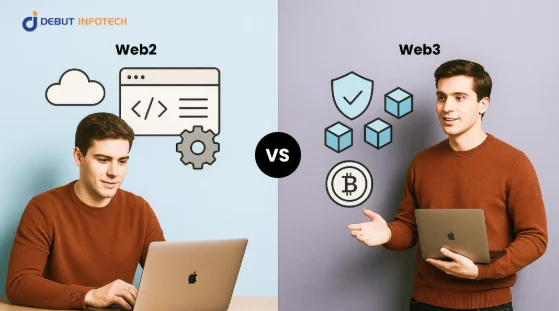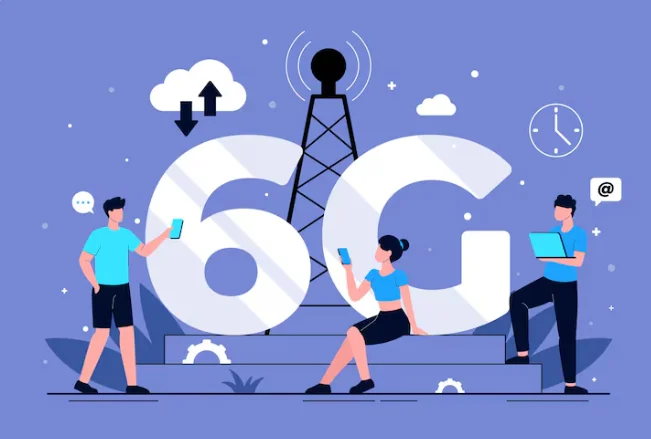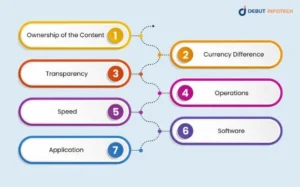Web2 vs Web3 Development: What Clients Must Know Before Building

The Internet has changed how we communicate, do business, and spread information. From the early powerpoints of Web1 to the user-first, vibrant communities of Web2, and now to the decentralized dreams of Web3. Every phase has its own architecture, value system, and set of opportunities.
In February 2025, there were around 5.56 billion global Internet users. The Internet and Web2 are the basis of most digital platforms that exist today. At the same time, Web3 adoption is steadily growing, with the global Web3 market projected to reach $33.53 billion by 2030, according to Grand View Research.
Anyone who wants to successfully navigate the present digital economy must understand Web2 vs Web3 Development. This article unpacks the origins of Web2 and Web3, their differences, business use cases, and limitations. It also offers guidance on when to choose one over the other.
What is Web2 and Web3?
Web2 is the second generation of the internet, whose focus is on user-created content, interactivity, and centralized platforms. It represented a fundamental shift away from static webpages to dynamic experiences, built and provided by platforms including Facebook, YouTube, and Google.
Web3, meanwhile, is the promised next chapter of the internet, built on decentralization, blockchain integration, and greater user control. It’s a project trying to reclaim power from internet monopolies for users by using distributed technologies and token economies.
Origin of Web 1, Web2 and Web3
The evolution of the internet is marked by three major phases—Web1, Web2, and Web3. Each phase has reshaped how users interact with content, data, and one another. To decide on Web2 vs Web3 Development, it’s crucial to understand their origin.
1. Web1 (The Static Web)
Web 1, spanning the early 1990s to early 2000s, was the internet’s first public version. It was largely a read-only space with static websites hosted on personal or institutional domains. Content creation was accessible to a few individuals or organizations. At the same time, users mostly consumed information—text, images, or links—with little interaction. Websites lacked user accounts, dynamic design, and interactivity. It functioned as a digital noticeboard, where information flowed one way—from publisher to viewer.
2. Web2 (The Social Web)
In the mid-2000s, Web2 arrived with dynamic content, user-driven websites, and interactive apps. Sites such as Facebook, YouTube, and Twitter allowed users to share, comment, and collaborate. Web 2 also ushered in centralized services in which platforms monetized user interests with ads. It transformed e-commerce, online education, and mobile use, powered by APIs and cloud computing. But, it also helped tech giants gain a big hold on user data and access to digital ecosystems.
3. Web3 (The Decentralized Web):
By decentralizing ownership and control, Web3 is an evolution of the Web2 model. Built on the blockchain, it allows users to own their identities, distribute content, and engage in transactions directly, without the need for intermediaries.
Web3 centers on digital ownership through NFTs, DeFi, and tokenized economies, as well as transparency through smart contracts and DAOs. There, users can be shareholders, not merely content contributors. The objective is to minimize dependence on centralized third parties and place individuals in charge of their data, assets, and online presence.
Web2 Vs Web3: Practical and Structural Differences
To properly understand this transition from Web2 to Web3, we should look at how they differ across some of the core components of digital activities. Before going into Web2 vs Web3 development, here are the most relevant differences between web2 and web3:
1. Ownership of the Content
Web2 platforms own and manage user data and content, often monetizing it through advertising or internal algorithms, with limited benefit to the creator.
By contrast, Web3 ensures users retain complete control through blockchain-based systems and NFTs. This allows direct monetization and rights protection without centralized oversight or platform dependency.
2. Currency Difference
Web2 systems use government-issued currencies and rely on intermediaries like banks and payment gateways, introducing delays, fees, and regulatory barriers.
In contrast, Web3 leverages cryptocurrencies for direct, peer-to-peer transactions—faster, borderless, and programmable through smart contracts. This eliminates third-party interference in digital commerce.
3. Transparency
Web2 operates through closed, proprietary codebases and decision-making, which keeps users mainly in the dark regarding what’s going on behind the scenes.
Web3, on the other hand, embraces open-source protocols and public ledger technology. It allows us to see and verify what is happening and to engage trustlessly according to the dictates of code and community consensus.
4. Operations
In Web 2, corporate teams or executives control updates, rules, and changes, with little user influence in decision-making or platform direction.
Unlike Web2, Web3 introduces decentralized governance, where users holding tokens participate in proposals and votes. This ensures community-led development and greater platform accountability.
5. Speed
Centralized infrastructure gives Web2 platforms the advantage of high-speed performance in real-time content delivery, transactions, and user responsiveness.
However, Web3 networks are slower due to distributed consensus mechanisms. Well, innovations like Layer 2 scaling and sidechains are closing the gap while preserving decentralization.
6. Software
Much of the web2 software is owned by a particular developer. This limits the ability to develop or make changes, and separates servers of like systems from one another.
On the other hand, Web3 software is generally open source, modular, and composable. This allows developers to audit, fork, and build on existing frameworks while promoting interoperability and shared progress.
7. Application
Web2 apps operate on centralized servers and employ traditional login credentials to authenticate users. This makes them vulnerable to data mining and platform lock-in.
On the flip side, Web3 applications (dApps) are accessed through blockchain platforms, networks, and crypto wallets. This allows data self-custody, permissionless engagement, and decentralized value transfer in user-owned ecosystems.
Web2 Vs Web3: Which One is Better for Business?
Depending on your business structure, goals, and customer expectations, Web3 vs Web2 development offers unique advantages. The right choice depends on whether scalability, control, innovation, or user ownership takes priority.
1. Scalability and Infrastructure
Web2 offers mature infrastructure and enterprise-grade cloud platforms like AWS or Azure, which support fast scaling and integration.
On the other hand, Web3’s infrastructure is still evolving, and scalability depends on emerging Layer 2 solutions and interoperability blockchain ecosystem prFotocols. This may pose integration hurdles for large-scale commercial deployment.
2. Data Control and Ownership
Web2 businesses depend on centralized data models because it enable easy data storage and user tracking for analytics and marketing.
In contrast, Web3 is built on user sovereignty, so businesses will need ethical, decentralized ways to interact with customers and manage identity without jeopardizing compliance or security.
3. Revenue Models
Traditional Web2 revenue streams—subscriptions, ads, and e-commerce—are well-established and easy to scale across global markets.
By contrast, Web3 introduces tokenized economies and smart contract-based payments, offering new monetization paths. The issue is that these models may be more complex to navigate legally and strategically for new entrants.
4. User Trust and Transparency
In Web2, companies frequently encounter skepticism regarding the use of data, privacy, and algorithmic biases as systems are closed and not transparent.
Web3, on the other hand, features open, auditable code and decentralized governance. This can reinforce user trust, particularly in industries such as finance, healthcare, and supply chain, where transparency is essential.
5. Innovation and Differentiation
Web2 businesses compete through branding, UX, and service differentiation in crowded markets.
Meanwhile, Web3 offers early-mover advantage in decentralized apps (dApps), DAOs, and NFT-based platforms, helping businesses stand out. However, adoption still requires educating mainstream users and adapting to regulatory uncertainty.
Limitations of Web3
Web3 offers innovation but still faces hurdles. Complex user experiences, regulatory uncertainty, environmental concerns, and limited interoperability challenge mainstream adoption.
Businesses must assess these issues, like crypto wallet requirements and unclear compliance rules, before committing to full-scale Web3 development. Progress is underway, but broader usability and legal clarity are still evolving.
Should you choose Web2 or Web3? Or Both?
1. When to Choose Web2
To end the debate on Web2 vs Web3 development, Web2 is ideal for businesses prioritizing reliability, fast adoption, and broad accessibility. For example, an e-commerce platform wanting seamless payment gateways, quick customer onboarding, and established marketing tools will benefit from Web2’s mature infrastructure and centralized services.
Similarly, content streaming services or corporate websites needing scalable cloud hosting with robust security often prefer Web2’s tested solutions.
If the primary goal is rapid growth with low technical barriers, Web2 remains the practical choice.
2. When to Choose Web3
To conclude on Web2 vs Web3 development, Web3 is a good fit for projects that prioritize decentralization, user ownership, and innovative business models. For instance, a DeFi platform handling trustless transactions and smart contracts must use Web3 in order for direct peer-to-peer financial transactions to be possible.
When artists are looking to monetize digital art with NFTs, they benefit from ownership transparency and easily automated royalties within Web3.
If your business seeks to promote community-led governance or elevate data privacy through blockchain technology, Web3 offers unique strategic benefits.
3. Mixed Use Cases
In Web2 vs Web3 development, hybrid approaches involving Web2 and Web3 can also make sense. For instance, a social media platform might use Web2 for fast user onboarding and content delivery while integrating Web3 features such as token-based rewards or decentralized identity verification.
Similarly, supply chain companies could maintain traditional Web2 databases for operational efficiency but deploy Web3 smart contracts for auditability and transparency in product provenance.
As web3 and web2 differences are glaring, choosing the right mix depends on business priorities, technical capabilities, and customer expectations.
Conclusion
Web2 and Web3 each serve distinct purposes. Web2 offers established, scalable systems for mainstream applications, and Web3 presents a forward-looking model centered on decentralization, ownership, and innovation.
As companies and individuals learn and shift their expectations, knowing and leveraging the correct strategies for Web2 vs Web3 development is important. You must weigh factors such as infrastructure maturity, transparency, governance, and user control to decide the best path forward.
If you’re looking for full-scale Web2 or Web3 solutions tailored to your business needs, Debut Infotech is a trusted technology partner. They also provide blockchain development services. From building scalable Web2 applications to launching secure, blockchain-based Web3 platforms, they empower startups and enterprises to innovate confidently.
Therefore, if you need traditional development or decentralized platforms, Debut Infotech combines deep industry knowledge with modern tools to help your business stay competitive in the present digital space.

The Hidden Business Power of Storytelling Through Books

Diamond Painting Apps & Digital Tools for 2025 Artists

Meeting Global Tastes: The Versatility of Commercial Tortilla Makers

Accelerating drug discovery through the DEL-ML-CS approach

AI in Marketing Is No Longer a Buzzword — It’s the Strategy

The Full Guide To Penetration Testing

Pixel 10 Pro Fold Case: Why Choose Aramid Fiber?

MT4 for Mac vs Windows: Which Version Works Better for Traders









